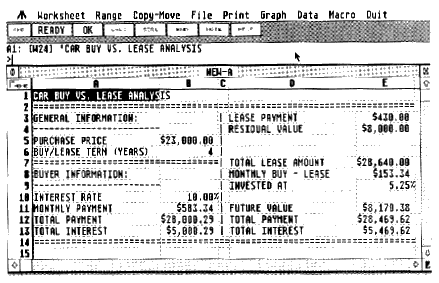Applications
Doing Spreadsheets
on the ST, Part II
BY CHRISTOPH L. HERD
Buying or leasing a car? Find out which is best for you with BUYLEASE.ARC on your START disk.
In the first installment of this column (START, June 1989)1 showed you how to create a spreadsheet to calculate the equity in financed real estate. This time I'll attempt to answer the question, should you buy or lease a car? The information I give here will apply equally to businesses and homes. Listen well; I think you'll learn something here.
Remember that the spreadsheets I cover in this column are on your START disk and can be loaded into any Lotus 1-2-3-compatible program, of which there are now two excellent ones for ST users: LDW Power and VIP Professional. I'll also assume that you have some basic familiarity with spreadsheets.
Preparing the Tools
You'll find this month's spreadsheet template on your START disk in
the file BUYLEASE.ARC. Copy BUYLEASE.ARC to a blank, formatted disk and
un-ARC the file following the Disk Instructions elsewhere in this issue.
Remember, you'll need either LDW Power or VIP Professional to load this
template. Follow the program's instructions for loading a template file
and load BUYLEASE.WKS (Lotus 1-2-3 version 1.0 format).
For those who don't have this month's START disk, load your Lotus-compatible spreadsheet and set the global column width and display format. For most financial spreadsheets you'll want the format of Currency, Two Decimal Places. Note, however, that at this setting, four-digit values become too big for the default column width of nine. Also, analysis of almost anything of value will probably carry you into the four-digit range. Car-loan templates tend to need five-digit numbers (or a column width of 11), while real-estate templates require six-digit values (or a column width of 12).

Figure 1: Buy/Lease Statement. This spreadsheet template was
produced on LDW Power and is on your START disk in the archive
file BUYLEASE.ARC.
Lease or Buy?
Let's put this month's template to some practical use. The last time
I opened my Sunday paper, out fell the car section, and on the front page
an ad proclaimed "Drive our new Model XYZ Super Duper Turbo today for only
$430 per month!" "Wow!" I thought. "I wonder how much I would save by leasing
it, rather than buying it." Upon closer inspection, this is what the small
print said: 48 months closed-end lease, MSRP: $23,000, Residual Value:
$8000, Monthly Payment: $430.
spreadsheet does
not detract from its
usefulness.
Let's see what we can do with our spreadsheet (Figure 1). This is what the worksheet tells us: Assume you want the car, but wonder if you should lease at the lower payment, or buy outright at the higher financing payment. The purchase price of the car would have been $23,000. You're comparing leasing it for four years, then buying it at the residual value, with financing it to buy with a four-year financing term. Suppose your Credit Union offers you a 10-percent financing rate (cell B10), your monthly payment on the $23,000 loan would then be $583.34. This monthly figure, paid over four years, will result in a total payment of $28,000.29. The total amount of interest paid on the financing is then the difference between the total payment and the cash price. All this information is under General Information and Buyer Information.
So far, so good. Now let's see what leasing will do. The Lease Payment and the Residual Value are in cells E3 and E4, respectively. The Total Lease Payment is nothing but the Lease Term and the Residual Value multiplied by the Lease Payment. The Monthly Buy/Lease amount is the monthly amount you save by leasing: $153.34. Suppose you invested this amount at 5.25-percent interest in a special savings account. At the end of the lease, this account would have grown into $8,170.38, enough to take care of the Residual Value!
Your Total Payment, then, is your Total Lease Amount minus what your savings account earned you above and beyond the Residual Value (or vice versa). Finally, your Total Interest would be the difference between your Total Payment and the Purchase Price of the car, which is $5,469.62. This is the amount you can compare to the Total Interest cost of buying it, which is S5,000.29. As you can see, leasing the car will cost you $469.33 more.
And, Finally. . .
Once again, the brevity of the spreadsheet does not detract from its
usefulness. Open your Sunday paper now and experiment with your own figures.
If your lease payment is very reasonable, and if your purchasing interest
rate is rather high, you may find leasing actually cheaper than buying
outright at a financed rate! The only other comment I might make is about
the formula in cells A4 and A9, which neatly underlines the text in the
cell above. If you change this text, the length of the underlining will
be adjusted dynamically. The formula does not underline labels with leading
spaces well or cells with non-label content.
Christoph L. Herd lives and works in Colorado Springs, Colorado. He is a regular columnist for START.
PRODUCTS MENTIONED
LDW Power, $149.95. Logical Design Works, Inc., 780 Montague
Expressway, Suite 403, San Jose, CA 95131, (408) 435-1445.
CIRCLE 164 ON READER SERVICE CARD
VIP Professional, $149.95. ISD Marketing, 2651 John Street, Unit
3, Markham, Ontario L3R2W5, (416) 479-1880.
CIRCLE 165 ON READER SERVICE CARD